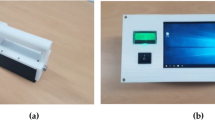Abstract
In the multi-layered track structure, the defects of cement-emulsified asphalt (CA) mortar are hidden and difficult to detect. There is still no effective detection method yet. Thus, this paper discusses the feasibility of mortar defect detection by transient elastic wave method. First, a finite-element model (FEM) was created by the LS-DYNA for a section of the multi-layered structure of the ballastless tracks, and the features of elastic waves were investigated in ballastless tracks with and without defects. Then, three identification parameters were presented and the spectra of measuring points were analysed in detail. Moreover, the IE method was adopted to detect the defects in the entity models of ballastless tracks. It is shown that the internal defects of the mortar layer can be pinpointed by comparing the waveforms of various frequencies in the frequency domain, different peaks of resonance frequency, and diverse power density values.












Similar content being viewed by others
References
Juanjuan R, Xiao L, Rongshan Y, Ping W, Peng X (2016) Criteria for repairing damages of CA mortar for prefabricated framework-type slab track. Constr Build Mater 110:300–311
Zhu S, Cai C, Zhai W (2016) Interface damage assessment of railway slab track based on reliability techniques and vehicle-track interactions. J Transp Eng 142(10):04016041
Qu H, Li M, Chen G et al (2016) Multi-bandwidth wavelet transform of impact echo signals for delamination detection of thin concrete slabs. J Civil Struct Health Monit 6(4):649–664
Krause M, Dackermann U, Li J (2015) Elastic wave modes for the assessment of structural timber: ultrasonic echo for building elements and guided waves for pole and pile structures. J Civil Struct Health Monit 5:221
Subhani M, Li J, Samali B (2016) Separation of longitudinal and flexural wave in a cylindrical structure based on sensor arrangement for non-destructive evaluation. J Civil Struct Health Monit 6(3):411–427
Chia-Tsung H, Yiching L (2016) Detecting debonding flaws at the epoxy-concrete interfaces in near-surface mounted CFRP strengthening beams using the impact-echo method. NDT E Int 83:1–13
Zhou CS, Wang P, Hu ZP, Zhu H (2014) Numerical simulation of impact-echo method identify the depth of honeycomb damage in unballasted track. Appl Mech Mater 584–586(1):2060–2067
Azari H, Nazarian S, Yuan D (2014) Assessing sensitivity of impact echo and ultrasonic surface waves methods for nondestructive evaluation of concrete structures. Constr Build Mater 71:384–391
Liu PL, Yeh PL (2011) Spectral tomography of concrete structures based on impact echo depth spectra. NDT E Int 44(8):692–702
Liu J, Xie J, He XY, He YS, Zhong JH (2014) Detecting the defects in concrete components with impact-echo method. Appl Mech Mater 577:1114–1118
Oh T, Park J (2014) Comparison of data-processing methods by air-coupled impact echo testing for the assessment of a concrete slab. J Test Eval 42(4):921–930
Zoidis N, Tatsis E, Vlachopoulos C et al (2013) Inspection, evaluation and repair monitoring of cracked concrete floor using NDT methods. Constr Build Mater 48(11):1302–1308
Waleed Mohamed Fouad Tawhed Fouad (2005) Assessment and prediction of damage in aged concrete bridge decks using the impact-echo method. University of South Carolina, Columbia, pp 76–80
Chen M, Feng SK, Che AL, Wang H (2014) Propagation characteristics of elastic wave in high-speed railway embankment and its application to defect detection. In: Advances in soil dynamics and foundation engineering. Proceedings of the 2014 Geo-Shanghai international congress. May 26–28, 2014, Shanghai, China, pp 20–28
Sadowski Ł (2015) Non-destructive identification of pull-off adhesion between concrete layers. Autom Constr 57:146–155
Yong Y, Zhao W, Du Y, Zhang H (2017) Analysis on directional feature extraction for the target identification of shallow subsurface based on curvelet transform. Dyna 92:293–299
Che AL, Tang Z, Feng SK (2015) An elastic-wave-based full-wavefield imaging method for investigating defects in a high-speed railway under-track structure. Soil Dyn Earthq Eng 77:299–308
Yeh PL, Liu PL (2008) Application of the wavelet transform and the enhanced Fourier spectrum in the impact echo test. NDT E Int 41(5):382–394
Acknowledgements
This work is supported by the National Natural Science Foundation of China (51578349), the Railway Ministry of Science and Technology Research and Development Program of China (2013G004-A-1) and Natural Science Foundation of Hebei Province (E2017210113).
Author information
Authors and Affiliations
Corresponding author
Rights and permissions
About this article
Cite this article
Tian, X., Zhao, W., Du, Y. et al. Detection of mortar defects in ballastless tracks of high-speed railway using transient elastic wave method. J Civil Struct Health Monit 8, 151–160 (2018). https://doi.org/10.1007/s13349-017-0265-0
Received:
Accepted:
Published:
Issue Date:
DOI: https://doi.org/10.1007/s13349-017-0265-0




